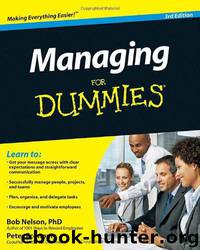Managing for Dummies by Bob Nelson & Peter Economy

Author:Bob Nelson & Peter Economy [Nelson, Bob & Economy, Peter]
Language: eng
Format: epub
Tags: Business & Economics, Leadership
ISBN: 9780470618134
Google: --1i-W-KJHMC
Amazon: 0470618132
Publisher: For Dummies
Published: 2010-07-06T00:00:00+00:00
If all actions are completed according to the bar chart, the third milestone will be reached on June 1. If some actions take longer to complete than estimated, you may not reach the milestone on time and someone may end up in hot water. Conversely, if some actions take less time than estimated, the milestone can be reached early (sounds like a bonus is in order!).
The advantages of the Gantt chart are its simplicity, ease of preparation and use, and low cost. Although Gantt charts work fine for a simple project such as preparing a budget, they’re generally unsuitable for large, complex projects such as building a space shuttle or doing your taxes.
Flowcharts
When the going gets tough, the tough get going — and they reach for their flowcharts. Although bar charts are useful for simple projects, they don’t illustrate the sequential flow of actions in a project (and, therefore, aren’t as 15_618134-ch10.indd 172
5/27/10 3:58 PM
Chapter 10: Monitoring Performance and Execution
173
useful for complex projects). On the other hand, flowcharts do a good job of illustrating this sequential flow. Although flowcharts look completely different than bar charts, they also have three key elements:
✓
Actions: In the case of flowcharts, arrows indicate actions. Arrows lead from one event to the next on a flowchart until the project is completed.
The length of the arrows doesn’t necessarily indicate the duration of an action. The arrows’ primary purpose in a flow chart is to illustrate the sequential relationship of actions to one another.
✓
Events: Events, represented in flowcharts by numbered circles, signify the completion of a particular action.
✓
Time: Time estimates are inserted alongside each action (arrow) in the flowchart. By adding the number of time units along a particular path, you can estimate the total time for the completion of an action.
Figure 10-2 shows a flowchart of the corporate budgeting example illustrated in Figure 10-1. As you can see, the flowchart shows exactly how each action relates to the others. By following the longest path in terms of time, you can determine the critical path of the project. This kind of analysis is called the critical path method (CPM) and assumes that the time to complete individual actions can be estimated with a high degree of certainty. The CPM highlights the actions that determine the soonest that a project can be completed — in this case, 30 days.
Third Milestone: Submit Draft Budget
Review
prior-year
reports
Create draft
Review draft
Submit
Figure 10-2:
Meet with staff
budget
budget
draft
A flowchart
15 days
5 days
5 days
budget
Review current
Review
for the
year-to-date
personnel
5 days
10 days
corporate
reports
status
budgeting
example.
Download
This site does not store any files on its server. We only index and link to content provided by other sites. Please contact the content providers to delete copyright contents if any and email us, we'll remove relevant links or contents immediately.
Hit Refresh by Satya Nadella(8863)
The Compound Effect by Darren Hardy(8523)
Change Your Questions, Change Your Life by Marilee Adams(7384)
Nudge - Improving Decisions about Health, Wealth, and Happiness by Thaler Sunstein(7255)
The Black Swan by Nassim Nicholas Taleb(6773)
Deep Work by Cal Newport(6574)
Daring Greatly by Brene Brown(6230)
Rich Dad Poor Dad by Robert T. Kiyosaki(6185)
Principles: Life and Work by Ray Dalio(5980)
Man-made Catastrophes and Risk Information Concealment by Dmitry Chernov & Didier Sornette(5659)
Playing to Win_ How Strategy Really Works by A.G. Lafley & Roger L. Martin(5524)
Digital Minimalism by Cal Newport;(5396)
Big Magic: Creative Living Beyond Fear by Elizabeth Gilbert(5360)
The Myth of the Strong Leader by Archie Brown(5243)
The Slight Edge by Jeff Olson(5202)
Discipline Equals Freedom by Jocko Willink(5159)
The Motivation Myth by Jeff Haden(5008)
Stone's Rules by Roger Stone(4866)
The Laws of Human Nature by Robert Greene(4787)
